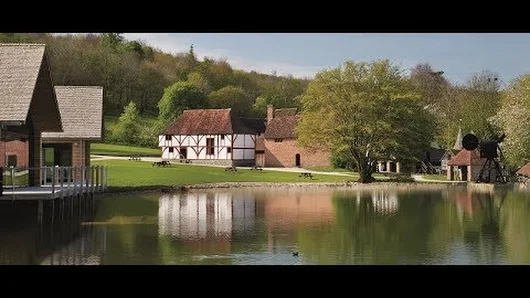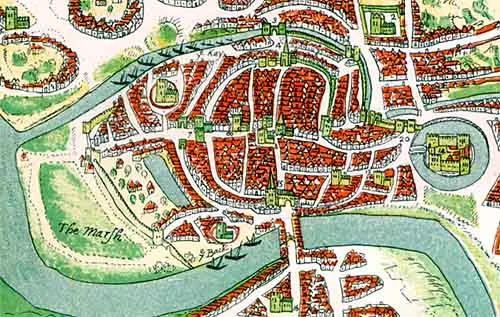A
fire brick,
firebrick, or
refractory brick is a block of refractory ceramic material used in lining furnaces, kilns, fireboxes, and fireplaces. A refractory brick is built primarily to withstand high temperature, but will also usually have a low thermal conductivity for greater energy efficiency. Usually dense firebricks are used in applications with extreme mechanical, chemical, or thermal stresses, such as the inside of a wood-fired kiln or a furnace, which is subject to abrasion from wood, fluxing from ash or slag, and high temperatures. In other, less harsh situations, such as a natural gas fired kiln, more porous bricks are a better choice. They are weaker, but they are much lighter, easier to form, and insulate far better than dense bricks. In any case, firebricks should not spall under rapid temperature change, and their strength should hold up well during rapid temperature changes.
In the making of firebrick, fireclay is baked in the kiln until it is partly vitrified, and for special purposes may also be glazed.
(Vitrification: The liquid-glass transition (or glass transition for short) is the reversible transition in amorphous materials (or in amorphous regions within semicrystalline materials) from a hard and relatively brittle state into a molten or rubber-like state. An amorphous solid that exhibits a glass transition is called a glass. Supercooling a viscous liquid into the glass state is called vitrification. Despite the massive change in the physical properties of a material through its glass transition, the transition is not itself a phase transition of any kind; rather it is a laboratory phenomenon extending over a range of temperature and defined by one of several conventions.)
The silica firebricks that line steel-making furnaces are used at temperatures up to 1650°C (3000°F), which would melt many other types of ceramic, and in fact part of the silica firebrick liquefies.
Fire clay is a specific kind of clay used in the manufacture of ceramics, especially fire brick.
The fire attribution is given for its refractory characteristics. There are two types of fire clay: flint clay and plastic fire clay. The raw materials normally used for making fireclay refractories consist of natural argillaceous materials whose mineral composition is represented by the general formula Al2O3 (aluminium oxide). The impurities in these raw materials are mainly present in the form of evenly distributed quartz, oxides and hydroxides of iron, hydrated haemetite and magnetite. Organic matter and sulphur compounds also may be present as impurities.
It is resistant to high temperatures, has a fusion point higher than 1,600°C, and therefore it is suitable for lining furnaces, as fire brick, and manufacture of utensils used in the metalworking industries, such as crucibles, saggars, retorts, and glassware. Because of its stability during firing in the kiln, it can be used to make complex items of pottery such as pipes and sanitary ware.
Unlike conventional brick-making clay, it is mined at depth, usually found as a seatearth associated with coal measures.
Seatearth is a British coal mining term, which is used in the geological literature. As noted by Jackson, a seatearth is the layer of sedimentary rock underlying a coal seam. Seatearths have also been called seat earth, "seat rock", or "seat stone" in the geologic literature. Depending on its physical characteristics, a number of different names, i.e. underclay, "fireclay", flint clay, and "ganister" can be applied to a specific seatearth.
Underclay, which consists of siliceous refractory clay rich in hydrous aluminum silicates, is also called "fireclay" (fire clay). Just as not all underclays are fireclays, not all fireclays are underclays. Within Carboniferous and other coal bearing strata, fireclay quite commonly comprises many underclays. In fact, within Great Britain, underclays, which are 3 to 9 feet (1 to 3 meters) thick, are major source of commercial fireclay deposits. The alteration of sediments by weathering, plants, and other soil processes comprising underclay resulted in the formation of vast majority of fireclay that comprises underclay.










